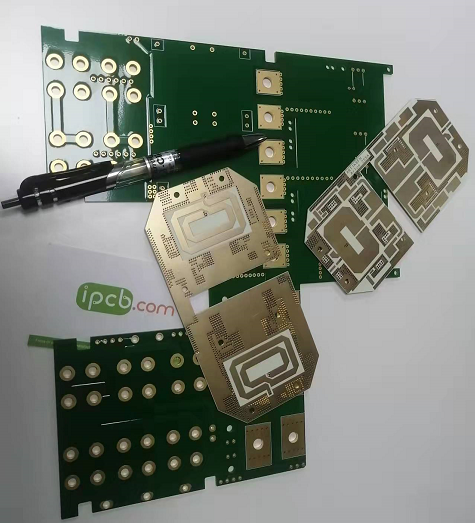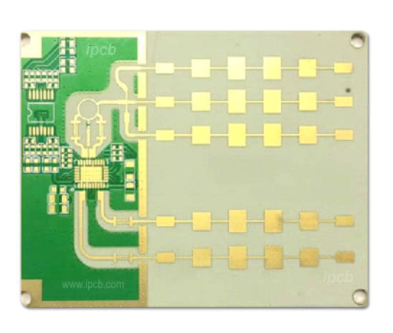- 13
- Dec
Cognition of High-Frequency Printed Circuts Board
Cognition of High-Frequency Printed Circuts Board
For special PCB with high electromagnetic frequency, generally speaking, high frequency can be defined as frequency above 1GHz. Its physical performance, accuracy and technical parameters are very high, and are commonly used in automotive anti-collision systems, satellite systems, radio systems and other fields. The price is high, usually around 1.8 yuan per square centimeter, about 18000 yuan per square meter.
Characteristics of HF board circuit board
1. The impedance control requirements are strict, and the line width control is very strict. The general tolerance is about 2%.
2. Due to the special plate, the adhesion of PTH copper deposition is not high. It is usually necessary to roughen the vias and surfaces with the help of plasma treatment equipment to increase the adhesion of PTH copper and solder resist ink.
3. Before resistance welding, the plate cannot be ground, otherwise the adhesion will be very poor, and can only be roughened with micro etching liquid.
4. Most of the plates are made of polytetrafluoroethylene materials. There will be many rough edges when they are formed with ordinary milling cutters, so special milling cutters are required.
5. High frequency circuit board is a special circuit board with high electromagnetic frequency. Generally speaking, high frequency can be defined as the frequency above 1GHz.
Its physical performance, accuracy and technical parameters are very high, and are commonly used in automotive anti-collision systems, satellite systems, radio systems and other fields.

Detailed analysis of High-Frequency Board parameters
High frequency of electronic equipment is a development trend, especially with the increasing development of wireless networks and satellite communications, information products are moving towards high speed and high frequency, and communication products are moving towards the standardization of voice, video and data for wireless transmission with large capacity and fast speed. Therefore, the new generation of products need high-frequency baseboard. Communication products such as satellite systems and mobile phone receiving base stations must use high-frequency circuit boards. In the next few years, it is bound to develop rapidly, and high-frequency baseboard will be in great demand.
(1) The thermal expansion coefficient of high-frequency circuit board substrate and copper foil must be consistent. If not, the copper foil will be separated in the process of cold and hot changes.
(2) High frequency circuit board substrate should have low water absorption, and high water absorption will cause dielectric constant and dielectric loss when it is affected with moisture.
(3) The dielectric constant (Dk) of high-frequency circuit board substrate must be small and stable. Generally speaking, the smaller the better. The signal transmission rate is inversely proportional to the square root of the dielectric constant of the material. High dielectric constant is easy to cause signal transmission delay.
(4) The dielectric loss (Df) of high-frequency circuit board substrate material must be small, which mainly affects the quality of signal transmission. The smaller the dielectric loss is, the smaller the signal loss is.
(5) Other heat resistance, chemical resistance, impact strength and peel strength of high-frequency circuit board substrate materials must also be good. Generally speaking, high frequency can be defined as frequency above 1GHz. At present, the high-frequency circuit board substrate that is more commonly used is the fluorine dielectric substrate, such as polytetrafluoroethylene (PTFE), which is usually called Teflon and is usually used above 5GHz. In addition, FR-4 or PPO substrate can be used for products between 1GHz and 10GHz.
At present, epoxy resin, PPO resin and fluoro resin are the three major types of high-frequency circuit board substrate materials, among which epoxy resin is the cheapest, while fluoro resin is the most expensive; Considering dielectric constant, dielectric loss, water absorption and frequency characteristics, fluororesin is the best, while epoxy resin is the worst. When the frequency of product application is higher than 10GHz, only fluororesin printed boards can be used. Obviously, the performance of fluororesin high-frequency substrate is much higher than that of other substrates, but its disadvantages are poor rigidity and large thermal expansion coefficient in addition to high cost. For polytetrafluoroethylene (PTFE), a large number of inorganic substances (such as silica SiO2) or glass cloth are used as reinforcing filler materials to improve the performance, so as to improve the rigidity of the base material and reduce its thermal expansion.
In addition, due to the molecular inertia of PTFE resin itself, it is not easy to combine with copper foil, so special surface treatment is required for the interface with copper foil. In terms of treatment methods, chemical etching or plasma etching is carried out on the surface of polytetrafluoroethylene to increase the surface roughness or add a layer of adhesive film between copper foil and polytetrafluoroethylene resin to improve the adhesion, but it may have an impact on the medium performance. The development of the entire fluorine based high-frequency board substrate requires the cooperation of raw material suppliers, research units, equipment suppliers, PCB manufacturers and communication product manufacturers, In order to keep up with the rapid development of High-Frequency circuit boards in this field.
